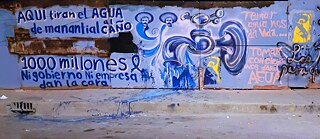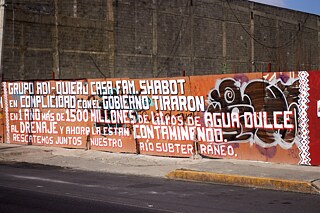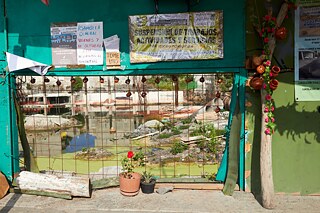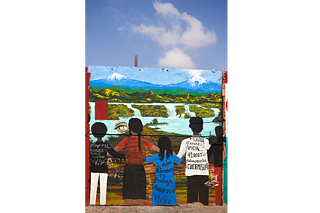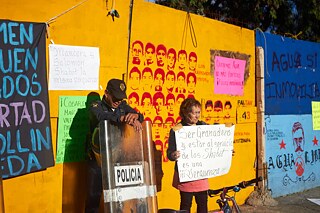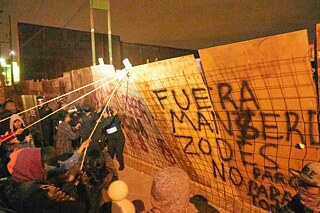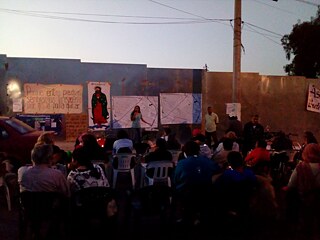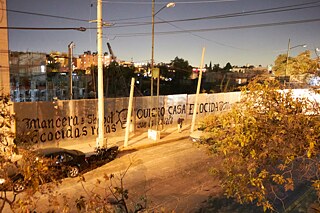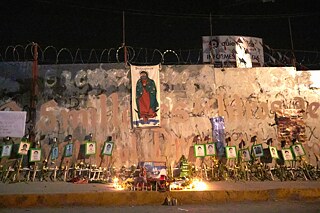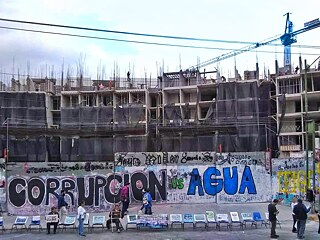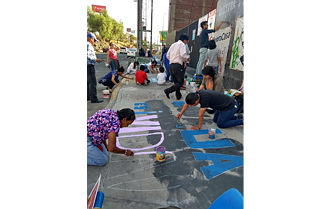Mexico City, Mexico
The wall and the source
Using murals to voice opposition: for those who see a large-scale architectural project in the south of Mexico City as posing a threat to their fundamental right to an adequate supply of fresh water, murals have offered an opportunity to express their opinions. And it has proven just as impossible to stop local people from appropriating the fence around the site as it has been to stem the invisible and incessant flow of water from it.
The source
In the south of Mexico City, between Tlalpan, Ciudad Universitaria and Santo Domingo, a layer of volcanic rock roughly ten meters below the earth’s surface extends across a radius of around 80 km2. It is the lava that flowed from the crater of the volcano Xitle some 1,700 years ago and became stone. Like an enormous sponge, the pores of this stratum of rock absorb all the water that accumulates in the few green spaces in this part of the city (in Tlalpan Forest and the Pedregal de San Ángel conservation area). A few decades ago, the villages of Los Reyes, La Candelaria, Ajusco, Santo Domingo, Santa Úrsula, and Ruiz Cortines were built right here on this layer of water and stone, lines of intersection being drawn all around the area: streets and transport axes now link the southern parts to the rest of the metropolis.In March 2015, a construction project commenced on one of these streets that run across the rock formation that is covered with houses. To this day, the edifice on the lot with the address Avenida Aztecas 215 sticks out from the urban tapestry of surrounding villages like a sore thumb: three turrets, 377 apartments and 683 parking spots. During the construction process, the clay and upper layers of earth were excavated that separated the groundwater from the surface. Then workers reached the harder strata of rock that needed to be removed to free up space for cellars and to lay the building’s foundations. When the steel of the construction machines broke through the volcanic rock, the water poured out of it as if from a bloated sponge.
A new source was thus created on the construction site and on one of the busiest streets in the south of the city.
The water gushed forth and the work took its course. Progress was made with the excavation work, supports were erected, and concrete was poured and hardened. Meanwhile, the water continued to flow incessantly. The construction company, apparently prioritizing progress on the building project over the contradictory reality of the ground’s composition, routed the stream of water to the nearest drain in an attempt to get rid of the groundwater in the rock and to conceal the leak.
The assembly
In early 2016, a number of local residents spotted a whole series of hoses running from the construction site in Avenida Aztecas 215 to the wastewater drains along the edge of the street. The water flowed continuously while construction work continued behind a two meter-high chipboard fence.For over a decade, the authorities responsible for the water supply in this neighborhood have ignored appeals from residents of these former villages. Many residents often have no choice but to make the trek to the offices of SACMEX (Mexico City’s waterworks) and then wait for hours in order to request a water truck that will supply them with sufficient water to meet their basic everyday needs. Yet at the same time, enough water to fill hundreds of trucks is gushing out of the construction site into the nearby drains every second.
A superfluity of water – in an area constantly beset by a shortage of water.
The sight drew more and more people from the surrounding neighborhoods to the wooden wall separating the construction project from the street. They removed the advertising posters that had been glued to the chipboard fence, leaving them bare and uncovered. At first ten people assembled in front of the hoarding – then there were 20, then 50, and later 80. Some positioned themselves along the curb so as to shield the wall from view, while others painted it blue along its entire length. The wood was now saturated with the color of the cloudless sky that is reflected in the still water. Pumps hummed on one side of the hoarding, while on the other hoses full to bursting ran directly to the gully cover.Within a matter of hours, or to be more precise between 4:00 and 9:00 pm on February 25, 2016, the hoarding was transformed into a protest manifesto: “Water keeps us alive”, “Environmental awareness preserves our water”, “Fresh source water is turned into wastewater here”, “The earth belongs to those who build on it; the volcanic rock belongs to those who live on it”. The fence around the construction site now enabled those assembled there to communicate with passers-by, who were able to read the messages displayed on the wall from Avenida Aztecas. A wall that in the subsequent months was to become many other walls.
In front of the redesigned fence, the residents of the local villages united to form the “Asamblea General de los Pueblos, Barrios, Colonias y Pedregales de Coyoacán”.
The wall
The wall is a message, a window, an altar, a classroom, a place of assembly, a battlefield.The hoarding has already assumed many different forms since February 2016. Its appearance has changed over the years, as has its height and length, and the material of which it is made: wood, metal, metal with barbwire, cement, steel. Soft wood was replaced by iron, and later concrete. This saw the wall become just as entrenched as the tensions between those who believe that the water is flowing directly from a huge aquifer, and those who view it merely as wastewater that needs to be got rid of as quickly as possible so as to create space for the city’s ongoing development.
After the wall had been painted for the first time between April and December, the Asamblea organized a vigil next to the construction site on Avenida Aztecas; this raised the profile and visibility of the protests and in many respects “activated” the hoarding. For example, local residents cut a hole in it through which a lake could be seen that attracted every conceivable form of life. On another occasion they projected images onto the wall, used the chipboard panels as blackboards for workshops, or allowed them to be used for the slogans of other protest movements, erected tents, set up altars or extended the fence to beyond the curb with the aid of interconnected colors, objects and actions.
The blockade was disbanded on December 5, 2016. The hoarding subsequently changed its appearance multiple times. The construction company replaced it with a new one that was then torn down by around 800 people, and which in turn was replaced by steel panels. Later, a brick house wall was erected in its place. The wall was rebuilt and demolished several times, in other words, yet thanks to the incessant protests of the Asamblea it repeatedly changed color over the course of the months. The protestors doggedly daubed it with messages and images, posters and symbols. It has proven just as impossible to stop the local people from appropriating the fence as it has been to stem the invisible flow of water from the construction site.
In response to the unyielding stance of the construction firm and the government, the Asamblea has attempted to soften this vertical and increasingly entrenched barrier.

